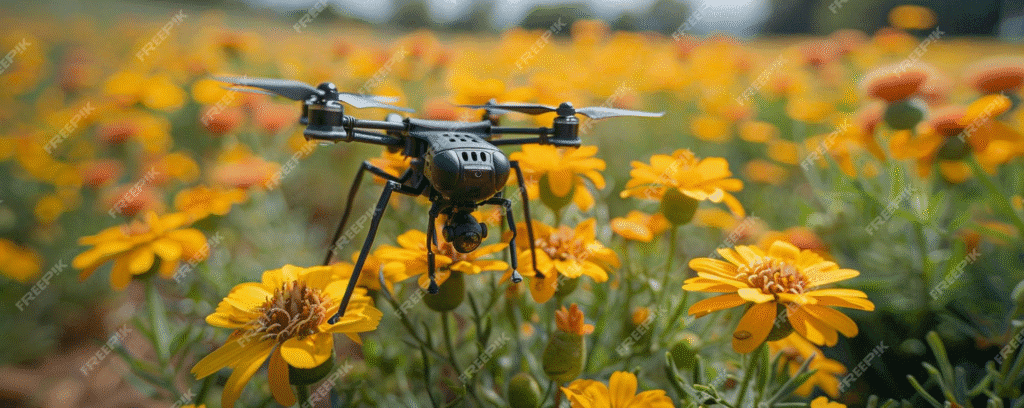Explore the future of farming with automated pollination technologies. Learn how robotics, drones, and artificial intelligence are transforming crop production amidst global pollinator decline.
Introduction
Pollination is a critical process for global food production, with over 75% of leading crop types depending on animal pollination. Traditionally carried out by insects like bees, butterflies, and birds, this natural service is now under threat due to environmental stressors such as habitat loss, pesticide use, and climate change. As pollinator populations decline, automated pollination has emerged as a promising technological solution to sustain and enhance agricultural productivity.
What is Automated Pollination?
Automated pollination is the use of technology—such as drones, robots, and artificial intelligence systems—to mimic or support the pollination process traditionally carried out by insects, birds, or wind. These systems aim to ensure effective fertilization of flowering crops when natural pollination is insufficient or unreliable.
Why Automated Pollination is Needed
1. Pollinator Decline
- Global honeybee populations are decreasing due to Colony Collapse Disorder, habitat loss, and pesticide exposure.
- Wild pollinators such as bumblebees and butterflies are also under threat, affecting both wild ecosystems and commercial agriculture.
2. Intensive Monoculture Farming
- Large-scale monoculture farms lack biodiversity, reducing the presence of natural pollinators.
- Manual pollination is labor-intensive and not scalable.
3. Controlled Environments
- In greenhouses or vertical farms, natural pollinators often cannot be introduced or sustained effectively.
Types of Automated Pollination Technologies
1. Drone Pollinators

- Miniature drones are equipped with soft bristles or gel to collect and transfer pollen between flowers.
- GPS and AI guide them to specific crops during flowering stages.
2. Robotic Arms and Mobile Pollinators

- Ground-based robots equipped with cameras and arms pollinate flowers individually.
- Some, like the Pollination Robot by Pollen Systems, use vision technology to locate and fertilize blooms.
3. Artificial Pollination Sprays

- Involves spraying a pollen solution directly on crops using tractors or aerial systems.
- More effective for mass-pollination but less targeted.
4. Electrostatic Pollination Systems

- Use electrically charged particles to attract and bind pollen, increasing efficiency.
- Common in indoor farming settings.
How Automated Pollination Works
- Sensing & Mapping: Cameras and sensors detect flower maturity, shape, and position.
- Navigation: GPS and AI algorithms guide drones or robots to optimal pollination zones.
- Pollen Transfer: Tools like brushes, gel-coated tips, or sprays transfer pollen precisely.
- Data Feedback: The system collects data on success rates and environmental conditions for optimization.
Benefits of Automated Pollination
✔ Reliability
It ensures pollination even in the absence of bees or in bad weather.
✔ Precision
Targeted pollination increases crop yield and reduces pollen waste.
✔ Scalability
Suitable for large-scale farms and greenhouses.
✔ Reduced Dependency
Reduces the burden on struggling natural pollinator populations.
✔ Year-Round Operation
Machines can work beyond traditional pollination seasons and in controlled environments.
Challenges of Automated Pollination
High Cost
Initial investment in hardware, software, and maintenance can be expensive for small farmers.
Technical Limitations
Current machines may struggle with delicate flowers or varied crop types.
Ethical and Ecological Concerns
Replacing bees raises questions about biodiversity loss and long-term ecological effects.
Energy and Resource Demand
Continuous operation requires energy and resources, potentially impacting sustainability.
Notable Innovations and Companies
- Brilliant Bee™ by Dropcopter (USA): Drone-assisted almond and apple pollination.
- Pollen Systems (USA): Data-driven pollination analysis and robotic pollinators.
- Arugga AI Farming (Israel): Robot pollination for greenhouse tomatoes using AI-powered machines.
- Eijiro Miyako’s RoboBee (Japan): A Harvard University collaboration with insect-sized drones for flower fertilization.
Future of Automated Pollination
The evolution of automated pollination will likely include:
- Swarm Robotics: Coordinated drone fleets mimicking bee swarm behavior.
- AI & Machine Learning: Enhancing flower detection, pollen application accuracy, and predictive pollination timing.
- Hybrid Models: Combining real pollinators with robotic systems to ensure maximum coverage.
Conclusion
Automated pollination stands at the intersection of ecological necessity and technological innovation. As pollinator populations continue to decline and food demand increases globally, this technology offers a promising solution to bridge the gap between sustainability and productivity. While not a full replacement for nature’s pollinators, automated systems can serve as an essential supplement in modern agriculture—especially in controlled environments, monoculture systems, and regions facing pollination crises.
FAQs on Automated Pollination
1. Can machines completely replace bees for pollination?
Not yet. While effective in certain environments, machines are still far from matching the efficiency, adaptability, and cost-effectiveness of bees in open ecosystems.
2. What crops benefit most from automated pollination?
Greenhouse tomatoes, apples, almonds, blueberries, and strawberries are early beneficiaries.
3. Is automated pollination environmentally friendly?
It depends on energy sources and manufacturing practices. It can be sustainable if powered by renewable energy.
4. How much does it cost to set up an automated pollination system?
Costs vary by technology and scale, ranging from several thousand to hundreds of thousands of dollars.
5. Are there regulations for using drone pollinators?
Yes. Most countries require drone operators to follow aviation and agricultural use laws.
6. Can automated pollination be used in vertical farming?
Absolutely. It is especially beneficial in enclosed environments where bees cannot thrive.
7. What are the main limitations today?
Cost, flower detection accuracy, and energy use remain key challenges.
8. Are there hybrid approaches with bees and machines?
Yes. Some farms use both to increase efficiency and reduce ecological impact.
9. What’s the success rate of robotic pollinators?
While improving, success rates vary by crop and system, ranging between 50–90% effectiveness.
10. What’s next for automated pollination?
Expect smarter systems, AI-driven precision agriculture, and broader adoption in developing nations.